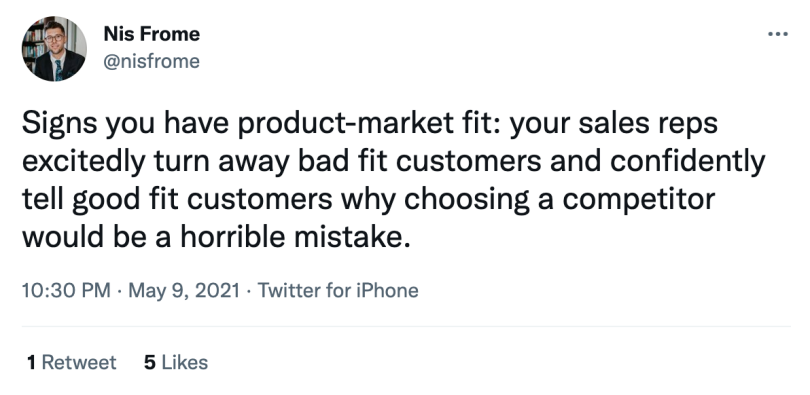You know the complaint: “Please, for the love of god, can you stop making this product worse?”
It’s almost a daily reaction many of us have to new features and app updates from products that used to be great but seem to keep getting worse. Though change can be difficult — even positive change — it does seem that many products and services do actually get worse over time.
Years ago, the issue for many startups was a lack of emphasis on market and customer feedback. Thanks to the lean and agile movements, the pendulum has swung in the other direction: Founders and product teams are drowning in feedback, and the challenge now is decision paralysis about what to prioritize next.
Without thoughtfully crafted systems in place, the overwhelming majority of raw customer feedback is noise consisting of random, misguided or misaligned suggestions that would result in wasted effort. That’s why, after achieving product-market fit and having a seemingly promising future, many products do, unfortunately, go sideways.
When it comes to noise, startups commonly make one of two mistakes. The first is that they don’t even recognize that suggestions could just be noise. Instead, they become addicted to feedback, thinking that they’re being “customer-obsessed.” In actuality, they’re laser-focused, like a cat chasing a meaningless red light. They’re prioritizing based on the latest and loudest suggestions, purposelessly hustling to nowhere.
The second and more noble but similarly mistaken approach is when companies recognize the importance of identifying signals and try to “tune out the noise.” The problem is that differentiating between the two is so tedious that it’s largely an exercise in futility. It’s like going to a fast-paced auction house and trying to authenticate every object during the bidding process. Markets move too fast for product teams to endlessly debate the merits of every customer suggestion in real time.
3 Lines of Communication Product Managers Must Monitor
- Listening: The distance from customers.
- Segmentation: The distance between customers.
- Responding: The distance to customers.
The ideal alternative is having a product strategy that prevents noise from entering your four walls in the first place. To do that, you have to understand how noise is generated and cut it off at the source. Similar to a game of telephone, noisy feedback is caused by interference that accumulates over distance. When it comes to product management, there are three specific lines of communication that need to be kept tight: distance from customers (listening), distance between customers (segmentation) and distance to customers (responding).
Let’s explore each, why interference tends to accumulate as companies grow and how to develop a strategy that ensures continuous noise prevention.
Listening: Distance From Customers
When it comes to product development, one of the main advantages that companies have early on is that there is no delegation. The founding team is often solving its own problem or otherwise must interface directly with the market to co-create a solution. There’s no game of telephone to be played. Feedback overwhelmingly consists of clear and actionable signals.
As companies grow, however, they eventually hire teams to manage existing customers (e.g. customer success and support) and teams to find new customers (e.g. sales and marketing) — further removing teams that build features for customers (e.g. product teams) from the actual market. In many organizations, product teams must rely on second- or third-hand feedback, rarely interfacing directly with customers. Distance from customers means that feedback is packed with bias and noise.
To prevent multiple layers from forming between product teams and customers, ensure that you facilitate a direct, ongoing line of communication between customers and product teams. Encourage customers to opt into beta programs where they can co-create and beta test new solutions with your product team. And when product teams aren’t in the room with customers, record and make the calls available. The more unfiltered feedback, the better.
Of course, you also have to ensure your product teams can engage customers without setting the wrong expectations in order to prevent sales and customer success teams from becoming territorial and overprotective of customer relationships in the first place.
Segmentation: Distance Between Customers
When you only have a few customers, there are a limited number of directions you can be pulled in. It’s relatively easy to articulate customer personas and stay true to a product strategy.
In order to hit revenue goals, however, companies will frequently sacrifice long-term sustainability to alleviate short-term pressures. The most significant mistake is to actively pursue customers with use cases that don’t fit into your company’s strategy. Suddenly, your team starts making exceptions and deviating from the product strategy.
Before long, your customer base will have demands that no longer intersect with one another and may even be contradictory. The distance between customers means you won’t be able to satisfy one customer or group without frustrating another. The result is a substantial amount of noise in customer feedback that can be impossible to reconcile. This is why many companies that achieve some degree of product-market fit quickly regress.
A company’s long-term viability depends on deliberately turning away bad-fit customers and focusing on an overlapping set of pain points and use cases as a principled strategy.

While it’s generally better to avoid having a fragmented customer base, there are certainly times when it makes sense to pursue different segments of a market. For example, using the same technology for both B2B and B2C could be a high-leverage growth strategy. Or perhaps you are introducing a product-led motion to a bonafide enterprise product. The key is to be proactive and cognizant about the market segmentation and to staff your product teams accordingly. Few product teams will be equipped to handle multiple customer segments simultaneously.
Responding: Distance to Customers
Even if you maintain a direct line of communication with an aligned segment of customers, it takes two to tango. You need to ensure that both parts of your feedback loop are efficient: inbound (listening) and outbound (responding). Response speed is tied to your product-development cycles and agility. From the time a signal is heard, how quickly can you address it?
There are two telltale signs that your company suffers from slow velocity. The first is that you simply don’t have the capacity to ship quickly or frequently. Your team is perpetually suffering from accumulated technical debt and limitations, and they’re overburdened by process. The second sign is that you’ve committed all your resources to a long-term roadmap. Even if you have the capacity to ship quickly, you’re so locked into obligations that you don’t have the capacity to pivot in response to changing markets.
In certain situations, it’s reasonable to have a product strategy that involves a long-term, detailed roadmap. But it can’t involve all your resources — otherwise your team won’t have any capacity to address unexpected but high-impact issues that arise.
When there’s too much time between decision and output, you end up solving yesterday’s problems. Customer expectations are constantly changing. You don’t want to be a product team that’s so slow to respond that you’re still trying to help people make indoor restaurant reservations in May of 2020 but still working on takeout orders in May of 2021. You will be responding to very real signals, but you’ll be doing it so slowly that you’re generating noise in the process.
The Takeaway
Customer feedback is oxygen for your company and product. But too often, companies are led astray by taking a misguided approach to being “customer-driven.” Consider whether there’s too much noise in your system — and how much more you’d thrive instead with these signals.





